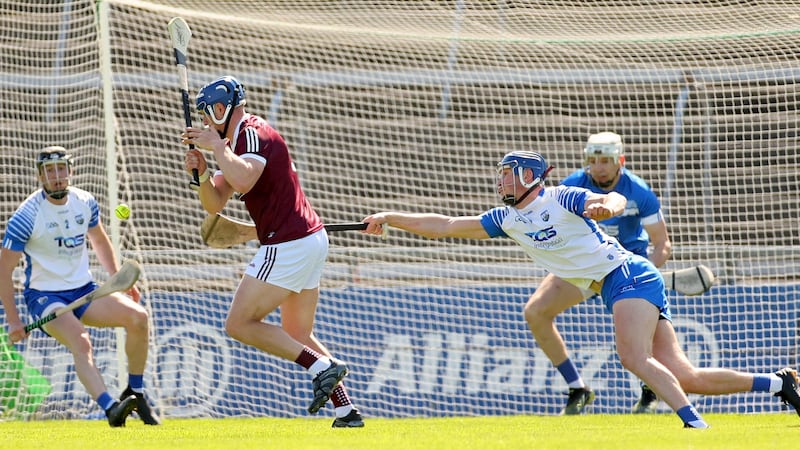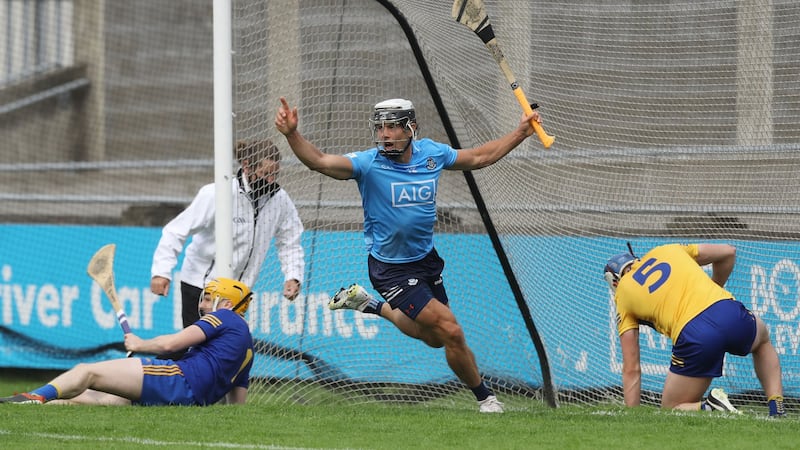The way Micheál Donoghue tells it, happenstance drove the record-breaking far more than any sort of design. Four years ago this weekend, his Galway team turned up in Tullamore and found themselves facing an Offaly side that lined up with not one but two sweepers. By the end of the 70 minutes, Offaly had indeed achieved their aim of not coughing up any goals. They did, however, concede 0-33 to Donoghue's Galway, then the most white flags ever raised in a single championship match.
The record lasted a fortnight, before Waterford put up 1-35 against Offaly in the qualifiers. But more eye-catching was the fact that Galway went all the way to the steps of the Hogan Stand without scoring another goal, ending their cloudburst of an All-Ireland with a goals per game average of 0.4, the lowest of an All-Ireland winner in history.
"There was never a game where we went out and said, 'take the points, take the points, take the points,'" Donoghue says now. "If you look back on 2017, you had Waterford and Wexford playing sweepers. Offaly played two the day we played them. So in every game, we were coming up against that.
“And because we had got used to it a bit through the league, we had become more mindful of it and more cognisant maybe of where we wanted to position our shooters. Take that Offaly game - when you’re playing against two sweepers, you really have to take what you’re given and change accordingly.
“Almost every game we went out, we were facing teams that had sweepers and that basically wanted us to shoot from distance and we just got better and more efficient at it as the games went by. Because of the quality of the players, it was possible to win games scoring from afar.”
In the seasons that followed immediately, Galway's All-Ireland looked as if it would stand out as an aberration. In general over the past decade, All-Ireland winners have typically needed to post in or around two goals a game. Limerick did that, more or less, in 2018 with 14 goals in eight games. Tipperary followed up in 2019 with 16, also in eight. Normal service looked to have resumed.
Forensic
But then Limerick won last year’s All-Ireland with just three goals in five matches. In fact, if you want to be forensic about it, they scored three goals in one match and none at all in the other four. The goals per game average for the All-Ireland champions plummeted back down to 0.6.
In all the recent frenzy over the escalating score totals, most of the focus has been on long-range shooting and the occasional descent into free-taking competitions. There has been very little chat, however, about the declining number of goals in the game. The trends in the game are clear.

During our conversation, Donoghue sends on a table compiled for him by some of the stats guys he had in the backroom team with Galway. It details the average goal shots per game and goals per game in matches since 2017. League and championship, top nine hurling counties only in order to take out any mismatches that might skew the numbers. It’s a pretty stunning demonstration of how the game has changed in a tiny space of time.
Since 2017, the goals per game average has dropped from 2.78 to 2.17. Most interesting of all, the goal attempts per game average has nose-dived from 6.83 to 3.5. The main inference from those numbers is that teams are being far more selective about when they go for goals - as well as more clinical in taking their chances.
“You are always looking for the highest rate of efficiency,” Donoghue says. “So if that’s working the ball to x part of the pitch and you can score from there, that’s what you will be trying to do. We went from having a scoring zone we felt we could be efficient in - and I presume every team has the same idea - we saw that scoring zone enlarge after the 2017 league as the conditions got better and the ground get harder.
“We analysed what worked and what didn’t. And so players had licence to shoot from distance rather than try to work it in because that had been shown to be efficient. The one time you would really question it, either in game or post-match, would be if there had been a one-on-one and the forward stepped back and took the easy option of the point.
“In those situations, we always went, ‘Did you ask the question? Did you ask the question?’ We didn’t want to fall into the trap of just being happy with points if there was more there on the table. Galway and Limerick have had success over the past few years in building scores without goals but you would still like to see more of it? Of course you would.”
Ah, but therein lies the question for the championship. Not ‘would we like to see more goals?’ but, rather, ‘will we?’ Limerick are the team to catch and they have shown that a lack of goalscoring is no barrier to success. They averaged 30 points a game in a winter championship played on soft ground and sometimes in a monsoon. They’ve set that as the baseline level for an All-Ireland tilt in 2021. Come and have a go if you think you can score enough.
Trench battles
They have made the terms and conditions very clear. They place huge emphasis on playing the game between the 65s, winning the trench battles in that area and using their pre-eminence to create space and overlaps.
The whole point of winning the middle third in hurling now is to parlay that victory into shooting opportunities from long and middle distances. They don’t see it primarily as a conduit to feeding ball to inside forwards. It’s no longer a case of cutting out the middlemen, it’s more that the middlemen are the ones now who do the cutting out.
“What Limerick are unbelievable at is the patience of the two inside forwards,” says Shane McGrath, Tipperary’s All-Ireland winning midfielder. “They stay in there, they don’t come outside to try and get involved in the play. That takes some patience. If you could close down the quality of ball going into them, you’d have a massive chance.
"But because they stay in there, they make the pitch so big, which helps the fellas playing the ball out the pitch. It leaves so much space to aim at, which means that half-backs have to be aware that they might get caught and so they can't fully commit to the middle third. Whereas if Aaron Gillane and Séamus Flanagan kept coming deep and trying to get a touch of the ball, the whole Limerick structure would be easier to defend against."
What about going in the other direction, though. It was clear during the league that some teams have made a firm decision that the only way to keep pace with Limerick will be to go chasing goals. Cork scored 18 goals, Galway plundered 12. Even taking out their games against Westmeath, both sides’ intent was clear, presumably with future engagements in mind.
"Let's go back to the All-Ireland final last year," says McGrath. "Waterford scored 0-19 and realistically afterwards, Liam Cahill had to be sitting down and saying, 'We're never going to beat Limerick with 19 points.' I think most teams have that attitude now that if you don't score at least a couple of goals against Limerick, you're not going to beat them. You're not going to get the chance to get enough shots off. The craziness in the middle third is all in Limerick's favour and they won't allow you to get enough shots off in there to match them.
“Performance wise, Cork were good in the league. They did well against Waterford, they did well against Tipp and should have closed it out, they messed about against Limerick and it was worse than a challenge match and they were okay against Galway. They obviously see their strength as being their hurling and I think that’s good for them.

"Step back from their set-up and ask can they compete man for man for long puck-outs. No, they can't, not throughout a game. Séamus Harnedy and Shane Kingston might be able to do it but they'll be in and out. So they will be working it through the lines. And it has worked for them so far. They've scored 18 goals in the league. It was 11 last year, four the year before. They have the pace, they have the hurlers, they can take teams on and they can score goals.
“There’s no way they can beat Limerick without scoring goals. They will have to score something like 3-20 to beat them. I think there’s far more chance of them doing that than scoring 32 points. Far more chance.”
Brass tacks
Donoghue has been there and done it. He agrees with the theory that teams will have to plunder goals to take Limerick’s title but he knows the brass tacks of it all too. Saying you need to score goals is like saying you want to save the planet. Nobody in their right mind is against the idea. Doing it is another matter.
“It’s easy to say you should be going for goals but it’s not that teams are not trying. Fundamentally, it’s not easy to score goals. The one question that you have to ask as a manager is when that one chance comes, are ye going to go for it, lads? I know it’s grand saying it in theory but if you’re not presented with the opportunity, it’s difficult.
“It’s just not as simple as saying, okay we’ll go for goals here lads. You work on stuff at training and it’s not like teams aren’t trying to score goals. My key thing is always when the chance comes, are you going to recognise that it’s on and are you going to ask the question?
“If it’s the case that you’re taking a handy point instead of pushing on for the goal, then we need to have a conversation. But goals aren’t easily scored. That’s the long and short of it. There’s no simple way to do it.”
There never was. More than ever though, contenders must find a way this summer. Otherwise, it looks like Limerick’s title.
Evolution of hurling scoring trends
By Leo McGough, hurling historian and statistician
Hurling’s H-scoring structure first saw the light of day in 1910 when the old side point-posts gave way to the crossbar and uprights that have stood the test of 110 years’ time. What better way to evaluate the history of SHC scoring than by tracing the exploits of the traditional big three of the game, the camán wielders of Kilkenny, Cork and Tipperary, ever-present at the business end for all 11 decades.
The early scoring trends, as can be seen from the accompanying charts, favoured the forwards locating the net, goals outnumbering points in the opening decade. Slowly, but surely, points became more plentiful and fast forwarding to the most recent decade we see how the white flag has completely taken over from the green as the favoured scoring option.
(Note: For the purposes of this chart the 2020 Covid-affected campaign has been included in the 2010s figures.)
Average goals per game scored by Cork, Kilkenny and Tipperary (by decade)
1910s 4.48
1920s 4.34
1930s 3.86
1940s 3.47
1950s 3.11
1960s 3.01
1970s 2.81
1980s 2.51
1990s 1.98
2000s 1.66
2010s 1.6
Average points per game scored by Cork, Kilkenny and Tipperary (by decade)
1910s 3.12
1920s 3.89
1930s 5.23
1940s 8.25
1950s 8.7
1960s 10.97
1970s 14.46
1980s 16.01
1990s 15.46
2000s 18.23
2010s 20.89
















